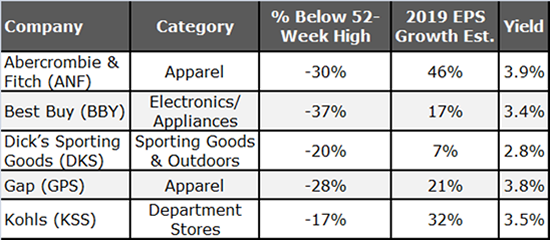5 Retail Stocks That Look Like Bargains
By all accounts, it was a productive holiday season for retailers across the country. Mastercard (NYSE: MA), which is uniquely qualified to monitor spending habits, estimates U.S. holiday spending rose 5.1% this year. That represents the sharpest annual increase in six years.
| —Recommended Link— |
| Is the Next “Millionaire Maker” In YOUR Portfolio? |
If prognostications from research firm eMarketer are accurate, brick-and-mortar stores rang up 4.4% more sales during the pivotal holiday season than in 2017, while eCommerce sales jumped 16%. Combined, shoppers dropped more than $1 trillion for the first time ever.
#-ad_banner-#Even when Halloween decorations were still on the shelf, there were already upbeat signs for retailers. Wal-Mart (NYSE: WMT) reported strong third-quarter comparable sales, led by a powerful 44% increase in online revenues, encouraging management to lift its full-year financial targets.
That jives with a report from the Bureau of Economic Analysis showing that consumer spending rose nearly 4% in the third quarter and is now running at an annualized pace of $14.1 trillion. The personal consumption expenditures (PCE) survey provided a granular breakdown on where this money went (food, clothing, durable goods, recreation etc.)
But that was just a preview of things to come.
Adobe Systems (Nasdaq: ADBE), which monitors activity at thousands of websites, estimates that internet sales surged 26.4% around Black Friday. Of course, Amazon.com (Nasdaq: AMZN) rang up more than its share of transactions.
Between Thanksgiving and the following “Cyber Monday,” the eCommerce giant sold an incredible 180 million items in just five days, a new record.
The question now is whether shoppers will keep their wallets open now that the Christmas trees have been taken down and the final gifts have been unwrapped. At least one influential CEO thinks so. Marvin Ellison of Lowe’s (NYSE: LOW) told analysts and shareholders recently that his company is anticipating “solid gains in consumer spending” going forward.
Of course, it’s easier to spend freely when you have a steady paycheck. And not only have unemployment levels plunged to the lowest levels in 50 years, but the tightening labor market has finally started to exert upward pressure on wages.
And I don’t know about you, but gas prices in my city have fallen below $1.80 per gallon. Cheaper fuel prices have effectively put more cash back in people’s pockets. That’s yet another reason why consumer confidence readings have soared to the highest levels in 18 years.
But stock prices tell a much different story. Between Thanksgiving and Christmas Eve (when stores were raking in cash hand over fist), consumer-facing stocks like Target (NYSE: TGT) and Best Buy (NYSE: BBY) were tumbling.
The SPDR S&P Retail ETF (NYSE: XRT), which tracks the performance of the nation’s top retailers, plunged 15.9% over that span and suffered its worst December ever.
That disconnect provided the motivation for a recent stock screen I shared with readers of my premium newsletter, Daily Paycheck.
The Screen
Here’s a snapshot of five dividend-paying retailers that could be poised for a bounce. Each has sold off sharply recently, yet has customers standing in line. In fact, these companies are projected to deliver earnings growth of up to 46% for 2018, bolstering future dividend distributions.

As always, the stocks in the table above haven’t yet been fully researched and shouldn’t necessarily be considered portfolio recommendations. They simply meet certain screening criteria that make them worthy of a closer look. With that said, here’s a closer look at some standouts…
The Results
Despite robust consumer spending tailwinds, these stocks are all trading at discounts of around 20% to as much as 30% below recent highs. Now, that alone doesn’t automatically make them good buys (they may have been overvalued before). Still, these are sizeable declines that could provide hefty upside potential.
Best Buy (NYSE: BBY), for example, has a consensus Wall Street price target of $73 (the stock was above $80 back in September). After retreating into the lower-$50s, that implies growth potential of nearly 40%.
Of course, many retail stocks have been punished for good reason. Take GameStop (NYSE: GME). The video game purveyor is struggling to adapt to the new digital-software download world, with earnings expected to slide to $2.66 per share this year from $3.34 in 2018.
By contrast, Best Buy is projected to deliver average annual earnings growth of 16% over the next five years. That should help sustain the upward trajectory in dividends, which have already marched from $0.19 to $0.45 per share since 2014 — an increase of 136%.
| —Recommended Link— |
| How To Exploit Stock Arbitrage On The NYSE “I had zero experience but made approximately $40,000 in 2 years.” Click here for details. |
For now, Best Buy enters 2019 with a full head of steam. The company just raised revenue and earnings guidance following a powerful third-quarter performance, with strength across numerous categories including gaming, headphones, mobile phones, and smart-home hub products.
Aside from the growing dividend, management intends to funnel $1.5 billion into stock buybacks in 2019. While the war with Amazon rages, Best Buy is more than holding its own and positioned to reward stockholders in the coming year.
I’ll be watching BBY as a possible candidate for my Daily Paycheck portfolio. But as with any official recommendation, my subscribers will be the first to hear about it.
In the meantime, feel free to research the names on this list further. But if you’d like to get access to my full portfolio — and put yourself on track to collecting a stream of dividend income each month, go here.
